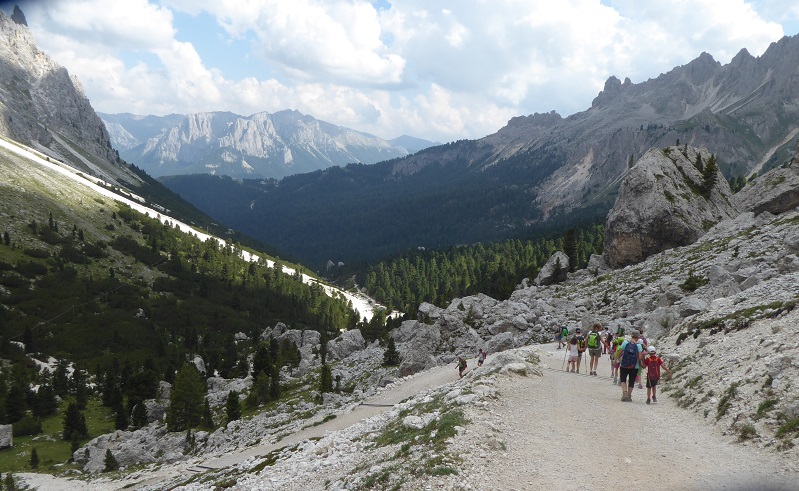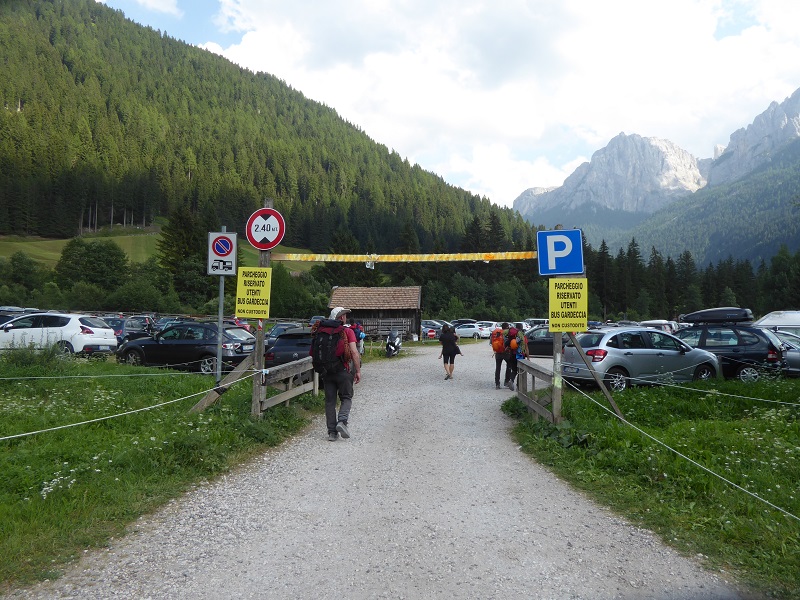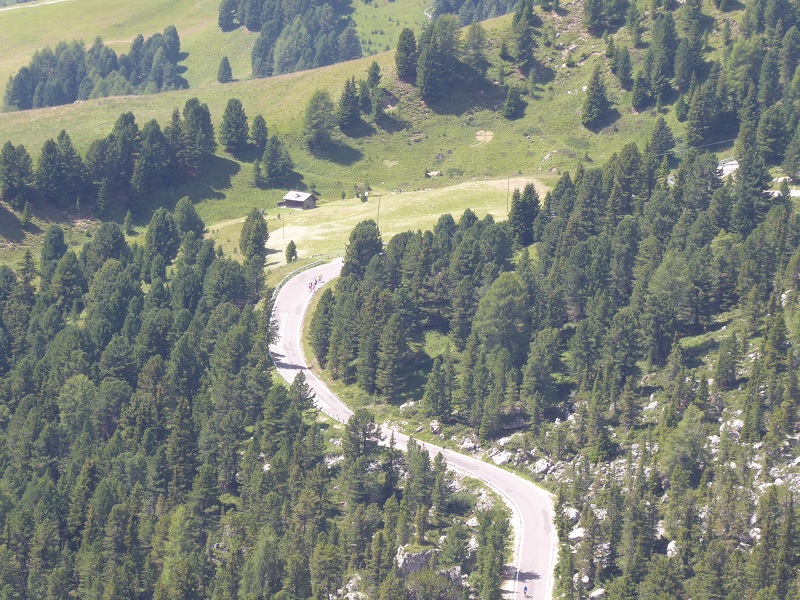
On Sunday afternoon, taking advantage of a break in the tropical storms which have been battering Scotland, we went for a walk up Ben Lomond, a hill that everyone from the west of Scotland who is able to do so should walk up at least once in their lifetimes. I walk, run or ski it most years. The drive from Balmaha to Rowardennan required patience because of the volume of traffic. It probably took us twice the time to drive it as it does in winter.

We met all sorts: small groups of middle aged men with strong Glaswegian accents, a couple of Asian families, backpackers taking a diversion from the West Highland Way, students, a person with a learning disability, Dutch tourists, some younger teenagers who must have been still at school, a Sikh……….we heard probably a dozen different languages. The number and diversity of people visiting Rowardennan and walking up Ben Lomond is a great thing. It should be the people’s hill.
The infrastructure though is creaking under the numbers and needs a re-think…………………in fact its needed a re-think ever since the Loch Lomond and Trossachs National Park was created.
In the Dolomites and indeed in many other valleys in the Alps where small roads finish in a dead-end without much space for parking – as at Rowardennan – they do things differently.

The main access to the Catinaccio group, off the Val di Fassa, is via this valley. The road up to the Gardeccia is closed to private cars. The valley is extremely popular – it leads up the famous Vajolet towers (where we climbed), offers great walking and a number of via ferrata – but people either walk up (rare), get a ski lift and then contour round into the valley or use the shuttle bus service from Pera.

The shuttle bus service operates from 7am to 6pm from the end of May until mid-October. It took about 20 minutes and cost 10 Euros return, including the cost of leaving our car for three days. It was extremely well used – we were concerned when we turned up at 7am whether we would get on the two buses waiting at the bottom – but coming back saw over half a dozen buses taking people up and down the route and waited just five minutes for our bus to fill and set off.

The road closure and shuttle bus service solves the problem of where people would park up the valley, takes the stress out of driving along the narrow road up to Gardeccia, provides jobs and is more environmentally friendly than people taking cars. This is not the only side valley off the Val di Fassa where such services exist (see here for list). So why don’t we do this in Scotland? We could start places like Rowardennan.
In fact, one of the action points of the east Loch Lomond Visitor Management Plan 2014-19 was:
“Consideration to be given to shuttle bus service provision from Drymen to Rowardennan.”

This has not been progressed. Instead, the focus has been on the expensive water bus service and there has been an obsession with trying to control car parking: in particular how to enforce the clearway between Balmaha and Rowardennan.
This has had the unfortunate effect of making much of east Loch Lomond inaccessible for people wanting to do short walks along the West Highland Way. Apart from the public carparks at Milarrochy, Sallochy and Rowardennan, there is nowhere to stop. Fine for fitter walkers, but for lots of people it means many of the joys of east Loch Lomond are now beyond reach.
A shuttle bus service would enable far more people to do shorter walks along east Loch Lomond, letting people walk between points of their choice. It would also make Ben Lomond far more accessible – something like 50% of the adult population of Glasgow do not have access to a car and effectively have no way of reaching, Ben Lomond, what should be the people’s hill.
The Buchanan Community Partnership and recreation management on east Loch Lomond
Unfortunately, not only does the LLTNPA appear to be doing nothing to address this situation, it and Stirling Council appears to be about to make this worse. The issue at stake is the management of the carpark at Balmaha.
There have been calls from people in Balmaha that the community should be able to benefit from the car park there for some time. There is a very interesting record of how the proposal has developed – given by Kevin Lilburn recorded in the minute of the May meeting of the Buchanan Community Council (see here). Basically the proposal had been that money raised from the car park should be split between Stirling Council, the LLTNPA and an organisation called the Buchanan Community Partnership. The plan which was eventually agreed was that Stirling Council would lease the car park which they still own for 3 years to the LLTNPA who would introduce parking charges through their newly procured Automatic Number Plate Recognition charging system. The LLTNPA would take on the burdens of running the carpark and after costs would share income with the community. The vehicle proposed to do this was the Buchanan Community Partnership
The BCP had been set up in 2003 to enable the local community to access and manage funds. It appears responsible for initiating the negotiations that car parking charges should be introduced at Balmaha and part of the money from this used to benefit the local community. The BCP has, according to Kevin Lilburn’s report to the Community Council – information reinforced by its accounts – been in “suspended animation” for a number of years. This is interesting as Kevin Lilburn is a Director of the Buchanan Community Partnership and information obtained under FOI FOI 2015 002 Response – Copy show that he represented that body on the east Loch Lomond Visitor Management stakeholder group, the body which is supposed to co-ordinate the implementation of the east Loch Lomond Visitor Management Plan (which now appears defunct) and indeed that he appears to have chaired meetings. Although in theory open to anyone from the local community to join, there is other information to indicate the BCP was hardly a democratic organisation. Information from companies house (see here) states it is controlled by one person, Joseph Twaddle its Secretary, who had been secretary of the Community Council before he resigned. The May minutes of the Buchanan Community Council record that “The view was expressed that the current BCC membership knew nothing about BCP meetings from the former Secretary”.
All this though now appears about to become history. According to the draft minutes of the Buchanan Community Council meeting in June the Buchanan Community Partnership is about to be wound up and instead there are plans that a new organisation, the East Loch Lomond Community Trust, will receive the funds.
14) AOCB
KL advised that the Buchanan Community Partnership (BCP) board had decided to start a process that aimed to wind up the BCP. This had implications for the “community” share of the revenue that might result from the proposed introduction of parking charges at the Balmaha car park. He understood that the recently formed East Loch Lomond Community Trust might now have an involvement.
It was proposed & agreed that the Chair should write to the NP expressing our deep concern at the situation.
Reading between the lines of the minutes, it looks as though one shadowy organisation, the BCP, has been replaced by one that is even more shadowy. Moreover, there has been no communication from the ELLCT and the Community Council, the organisation which represents people locally. Information on the Office of Scottish Charity Regulator’s website shows that the ELLCT was incorporated in October 2016 and sets out it general objectives but does not provide the names of the trustees or say what area it covers. The only other public information that is available about the ELLCT is it appears to have registered for Just Giving. You cannot therefore see who is controlling the organisation let alone what it intends to do. Perhaps the National Park knows?
What needs to happen
- The LLTNPA should make all information it holds on the east Loch Lomond Community Trust public and explain why it appears happy to divert funds to an organisation which appears accountable to no-one
- The LLTNPA needs to create an integrated vehicle management plan for the area. Charging for carparks has all sorts of implications for recreation management, including the viability of a shuttle bus service to Rowardennan. We bought our 10 euro return ticket in Italy and it covered carparking for three days. The car park at Balmaha is not big enough to cope with the extra car parking capacity that would be needed to support a shuttle bus service but income from it could be used to kick start such a service. The LLTNPA in giving away funds to an unaccountable group is reducing the likelihood of transport systems, which exist everywhere on the continent, being developed in the National Park.
- At the National level, it appears that the law regarding community councils needs to change (the minutes show the reason these trusts and companies are being set up are because of legal limitations as to what community councils can do). Now community councils are not perfect, they can easily be taken over, but as the saga on east Loch Lomond shows, the alternatives, companies or trusts accountable to no-one can be even worse.
And for any reader, who thinks I am being too radical, in Italy they are prepared to close to private vehicles not only dead-end roads, but major through routes.

The road over the Sella Pass, between the Val di Fassa and Val Gardena is closed between 9am and 4pm every Wednesday, except to buses and cyclists. Imagine us doing something as radical in Scotland? What the closure does is enable hundred of cyclists to enjoy the challenge without having to think about traffic, which includes not just car but lots of motorbikes. The Rowardennan Rd is a nightmare to cycle at present. A shuttle bus service might make it a pleasure to cycle again with additional recreational benefits – and help promote a circular route on car free routes from Balloch to Rowardennan, across to Tarbert on a ferry and then back down to Balloch along the west Loch Lomond cycle path. That would be a National Park which, like Italy, put outdoor recreation at the centre of how it manages the countryside.
They have a bus system in Snowdonia 5 years ago it was £1 each way from the bottom of the hill up to the parking area
There are some similar schemes in the French Alps as well, for instance in the Val Clarée near Briançon – 3 euros return this summer (and no charge for parking)